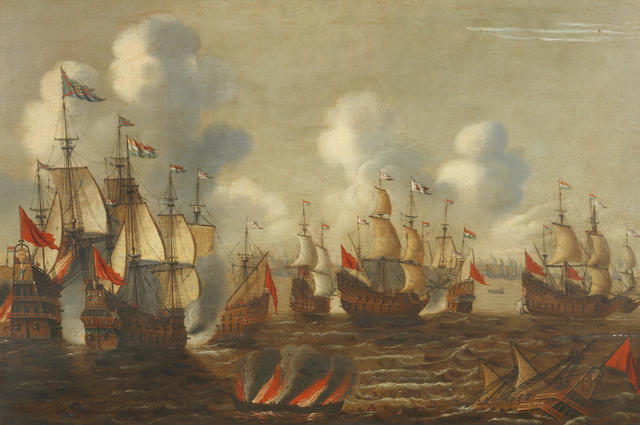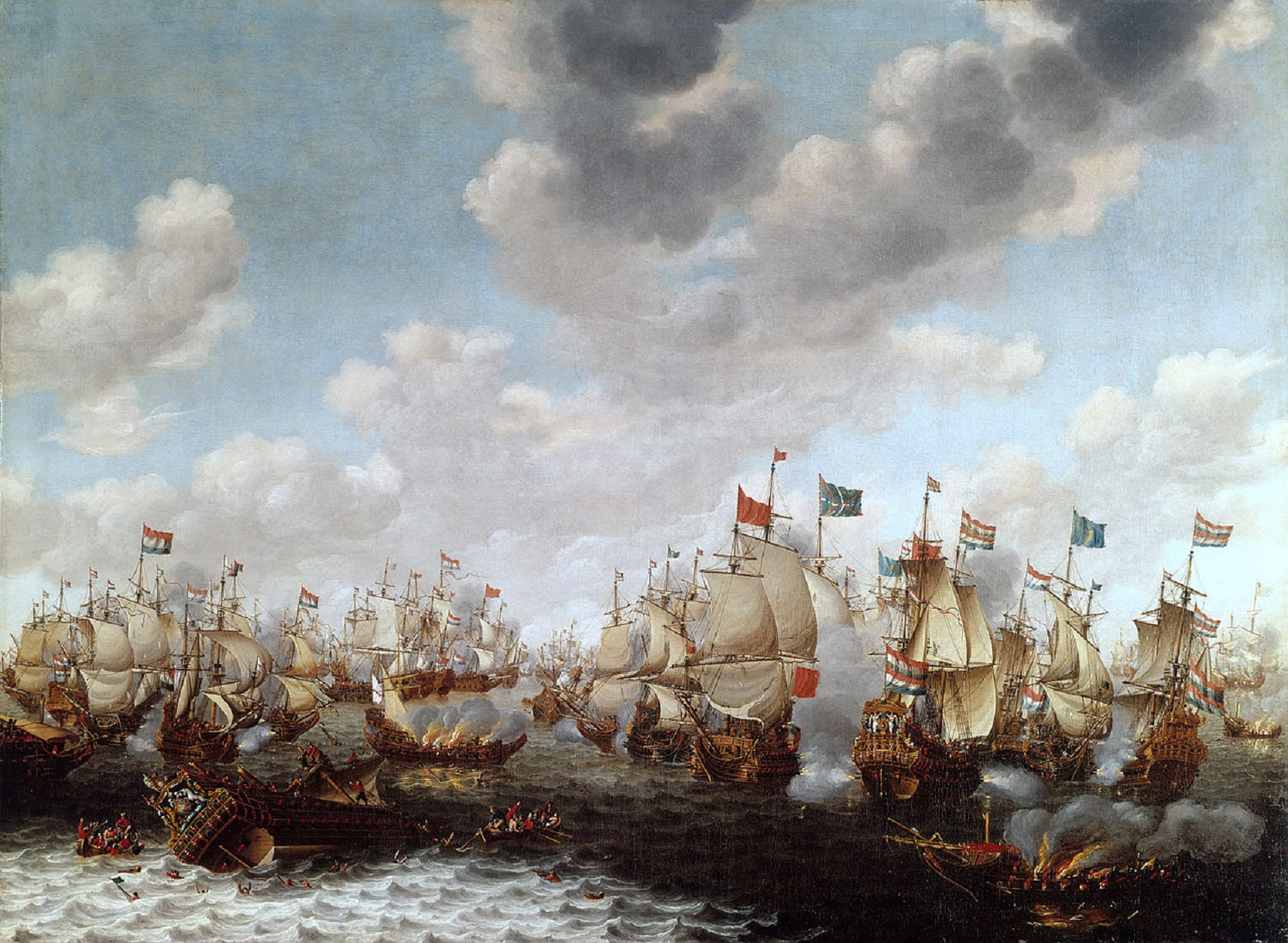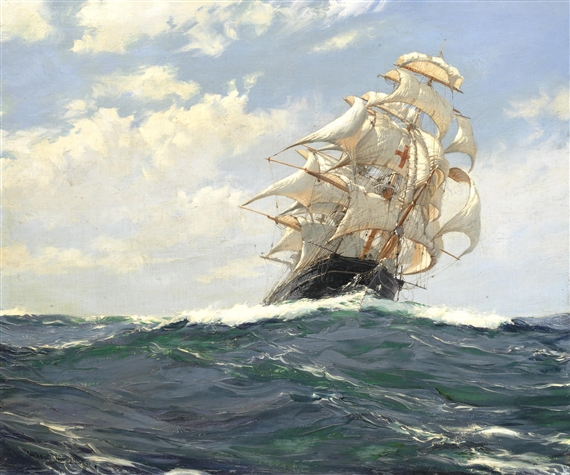
Martha Walter Am. 1875–1976
Gloucester Harbor
Watercolor
14 x 20 in. sight 35.6 x 50.8 cm
Martha Walter (March 19, 1875 – January 1976) was an American impressionist painter. A Philadelphia native, Walter studied art at the Pennsylvania Museum and School of Industrial Art from 1895–98 and at the Pennsylvania Academy of the Fine Arts, Philadelphia. She was taught by William Merritt Chase. She won the school's Toppan Prize and Cresson Traveling Scholarship. In 1909 also she won the school's Mary Smith Prize for the best painting by a resident female artist. On her scholarship she traveled to Spain Italy, the Netherlands and France. In France she received tuition from Rene Menard and Lucien Simon at the Académie de la Grande Chaumière.
She went on to teach art at Chase's New York School of Art. More

Charles Fromuth Am. 1858–1937
Soir de Peche, c. Octobre 1925
Pastel
16 1/2 x 18 in. 41.9 x 45.7 cm

Charles Fromuth Am. 1858–1937
Sailing Under an October Clearing 1929
Pastel
26 x 28 in. 66.0 x 71.1 cm
Charles Fromuth is an American painter born in 1866 in Philadelphia and died in 1937 at Concarneau. Charles Fromuth learned painting at the School of Fine Arts in Philadelphia under the direction of Thomas Eakins ; he discovers Europe and Paris in 1889. With the exception of a trip to the United States in 1910, he spent the rest of his life in Concarneau residing at the Hotel de France in this sardine port.
At the Universal Exhibition of 1900 , he discovered Japanese art, particularly Hokusai. Fromuth had the same view of nature that the Japanese, he worshiped the sea in all its forms. All his work is devoted to the craft of animation in the main port of Concarneau. "The movement is the thrust of my work," wrote Fromuth. He exhibited regularly in Europe, earning various awards and medals, until 1910. After that date, he devoted himself entirely to his hermit pastels and charcoal drawings depicting fleeing boats under sail. More

Charles Fromuth Am. 1858–1937
A Pot Boiler Effort
Pastel
12 1/2 x 24 in. 31.8 x 61.0 cm

Carlo Grubacs, 1812-1870
BOATS IN THE LAGUNA WITH A FLAG OF THE REPUBLIC OF SANTA MARIA, c. 1849
OIL ON CANVAS
50 x 62,5 cm ; 19 ¾ by 24 5/8 in
GRUBACS, Carlo, (b. 1812, Venezia, d. 1870, Venezia) is an Italian painter of animated urban waterscapes and architectural features. Carlo Grubacs was born in Venice in 1812. The son of a Merchant Navy captain whose family, originally from Montenegro, had settled in Italy in the second half of the 18th century, he belonged to the Venetian school of 'Vedutista' which had flourished with artists like Canaletto and Francesco Guardi in the 18th century.
He studied at the Academy of Fine Arts in Venice where he exhibited his works in 1847, 1855, 1858 and 1864. His paintings, often of a small size, offer carefully detailed and lively views of Venice, executed in the tradition of 19th century Venetian Vedute where the artist combines a smart and skillful drawing with a bright and luminous palette. More

In the style of Matthieu van Plattenberg
SHIPS IN THE STORM
Oil on paper
51.5 x 60 cm; 20 1/4 by 23 5/8 in
Matthieu van Plattenberg, (1607 or 1608 – 19 September 1660) was a Flemish Baroque painter, draughtsman, etcher and engraver who specialized in marine paintings and landscapes. He spent most of his career abroad, first in Italy and then in France where he played an important role in the development of the painting of stormy seascapes. More

Follower of Peter van den Velde (Antwerp 1634-1687)
A maritime engagement between the Dutch and the Spanish Netherlands
oil on panel
54.2 x 82.6cm (21 5/16 x 32 1/2in)
 Peter van den Velde (1634–after 1723)
Peter van den Velde (1634–after 1723)
The burning of the English fleet off Chatham, 20 June 1667, circa 1670 (1667-1700)
The Royal Charles is right of center
Oil on panel
73 × 108 cm (28.7 × 42.5 in)
Rijksmuseum, Amsterdam, Netherlands
 Pieter Cornelisz. van Soest (fl. 1642–1667)
Pieter Cornelisz. van Soest (fl. 1642–1667)
Attack on the Medway, c. before 1667
Oil on canvas
Royal Greenwich Museums, London, United Kingdom
 Pieter Cornelisz. van Soest (fl. 1642–1667)
Pieter Cornelisz. van Soest (fl. 1642–1667)
Four Days Battle (June 1666)
Oil on canvas
940 x 1283 mm
Royal Greenwich Museums
 Montague Dawson
Montague Dawson
Running free - the Yankee Packet Dreadnought
20.08 X 24.02 in (51 X 61 cm)
Oil on canvas
Spanish Netherlands (Spanish: Países Bajos españoles; Dutch: Spaanse Nederlanden) was the collective name of States of the Holy Roman Empire in the Low Countries, held in personal union by the Spanish Crown (Habsburg Spain) from 1581 to 1714. This region comprised most of modern Belgium and Luxembourg, as well as parts of northern France and Germany. The capital was Brussels.
The Imperial fiefs of the former Burgundian Netherlands had been inherited by the Austrian House of Habsburg from the extinct House of Valois-Burgundy upon the death of Mary of Burgundy in 1482. The Seventeen Provinces formed the core of the Habsburg Netherlands which passed to the Spanish Habsburgs upon the abdication of Emperor Charles V in 1556. When part of the Netherlands separated to form the autonomous Dutch Republic in 1581, the remainder of the area stayed under Spanish rule until the War of the Spanish Succession. More
After the death of the Spanish Habsburg King Charles II on 1 November 1700, his last will designated Louis XIV's second grandson Philip Duc d'Anjou as his successor. In spite of the protests of other powers the transition seemed to go smoothly at first. In September 1701 the grand alliance of the Hague was formed between the United Provinces, England and Emperor Leopold I, who had declared war in spring and thus started the War of the Spanish Succession. More
Peter van de Velde or Peter van den Velde (1634 – after 1723), was a Flemish Baroque marine painter who lived well into the 18th century. He was born in Antwerp where he became a master of the Guild of St. Luke in 1654. Between 1666 and 1680 he is recorded in the guild as having pupils. Between 1668 and 1675 he produced 50 paintings for the Antwerp art dealers Forchondt, who exported these to Vienna.
Considering the great age that this painter is supposed to have reached, it is possible that the name Peter van de Velde refers actually to two painters, maybe a father and son pair who signed with the same name. A son of Peter van de Velde was baptized in Antwerp in 1687. He is known for marines in stormy seas.
Peter van de Velde died some time after 1723, the latest date discovered on one of his paintings. More

The burning of the English fleet off Chatham, 20 June 1667, circa 1670 (1667-1700)
The Royal Charles is right of center
Oil on panel
73 × 108 cm (28.7 × 42.5 in)
Rijksmuseum, Amsterdam, Netherlands
The Raid on the Medway during the Second Anglo-Dutch War in June 1667, sometimes called the Battle of the Medway, Raid on Chatham or the Battle of Chatham, was a successful and daring attack conducted by the Dutch navy deep upriver targeting the largest English naval battleships at a time when most were virtually unmanned and unarmed, laid up due to lack of funding in the fleet anchorages off Chatham Dockyard and Gillingham in the county of Kent. At the time, the fortress of Upnor Castle and a barrier chain called the 'Gillingham Line' were supposed to protect the mothballed naval ships anchored off Chatham, the main English naval base in southeastern Stuart England. More
Peter van den Velde (1634–after 1723), see above

Attack on the Medway, c. before 1667
Oil on canvas
Royal Greenwich Museums, London, United Kingdom
Attack on the Medway, June 1667 by Pieter Cornelisz van Soest, painted c. 1667. The captured ship Royal Charles is right of center.
Pieter Cornelisz van Soest (born ca. 1600-1620, flourished ca. 1640–67) was a Dutch marine artist, especially prolific in battle-pieces.
Little is known about him. In 1642 he became Poorter of Amsterdam where he was recorded until 1667. Among his subjects are the Battle of the Downs and the Second Anglo-Dutch War, particularly the Raid on the Medway. Van Soest also depicted the ships Comet Star and Eendracht. His paintings usually have a panoramic view of the battles. Van Soest rendered ships with delicate brushstrokes, while a light impasto is a feature of his skies. More

Four Days Battle (June 1666)
Oil on canvas
940 x 1283 mm
Royal Greenwich Museums
Four Days Battle (June 1666), see above
Pieter Cornelisz. van Soest (fl. 1642–1667), see above

Running free - the Yankee Packet Dreadnought
20.08 X 24.02 in (51 X 61 cm)
Oil on canvas
Although stated to be a medium clipper, Dreadnought's lines bore more resemblance to those of a contemporary packet than an ocean thoroughbred. Built by Currier & Townsend at Newburyport, Massachusetts, she was launched on 6th October 1853 and was ready for sea the following month. Her owners, the Red Cross Line, had ordered her for their New York to Liverpool service and, having chosen Captain Samuels as her master, they asked him to superintend her construction. The result was a fast and reliable ship that became known as "the wild boat of the Atlantic", a reputation also helped by Samuels' superb seamanship and his determination to drive her with the maximum sail whatever the weather. Curiously she broke no records but she maintained her Atlantic schedules with greater regularity than any other sailing packet then afloat. Between December 1853 and February 1864, she completed thirty-one round trips for the Red Cross Line, Captain Samuels remaining in command for all but the last voyage. In the summer of 1864, Dreadnought was sold but put onto the New York to San Francisco run where she remained for several years. On 28th April 1869 she sailed from Liverpool again, bound for San Francisco, but was wrecked on the island of Tierra del Fuego just prior to rounding Cape Horn. All of Dreadnought's officers and crew were saved but the ship herself was a total loss and cost her underwriters $83,000. We are grateful to Michael Naxton for his assistance with cataloguing this lot. More
Montague Dawson RMSA, FRSA (1890–1973) was a British painter who was renowned as a maritime artist. His most famous paintings depict sailing ships, usually clippers or warships of the 18th and 19th centuries. More
Images are copyright of their respective owners, assignees or others



No comments:
Post a Comment